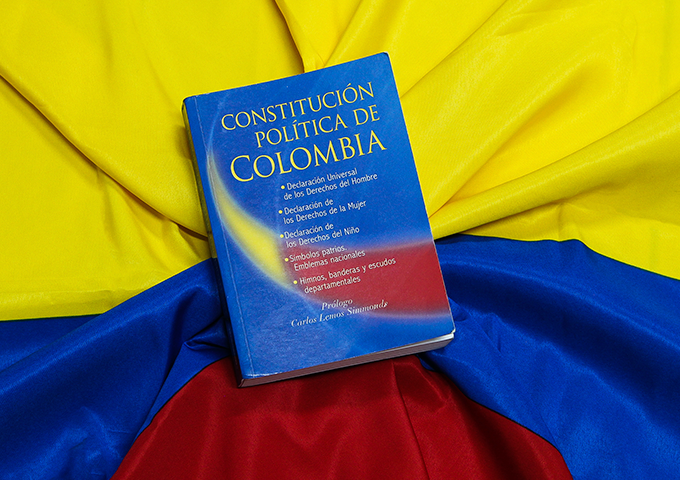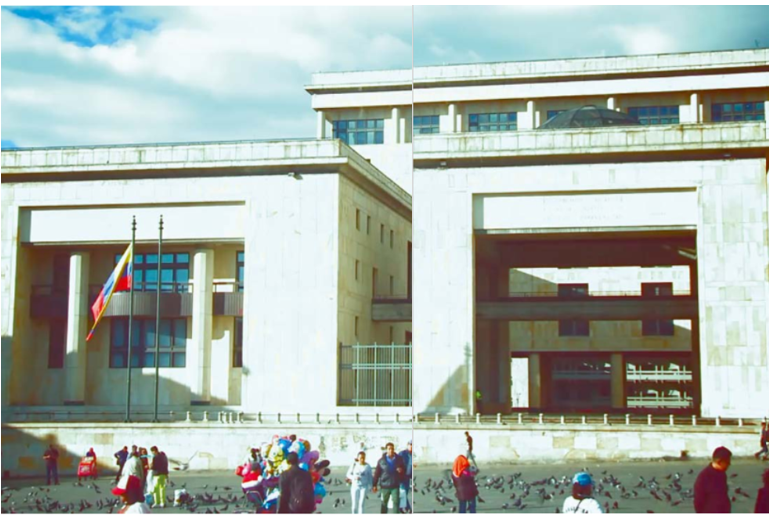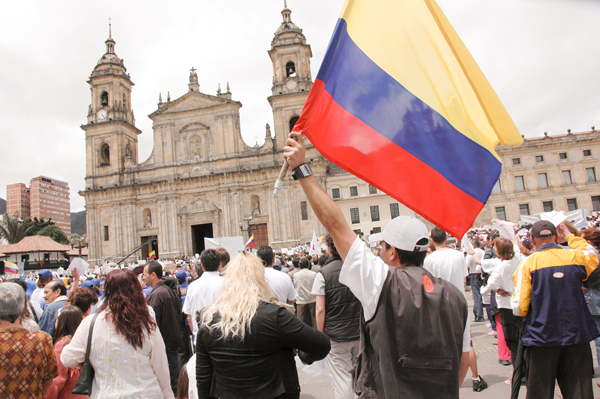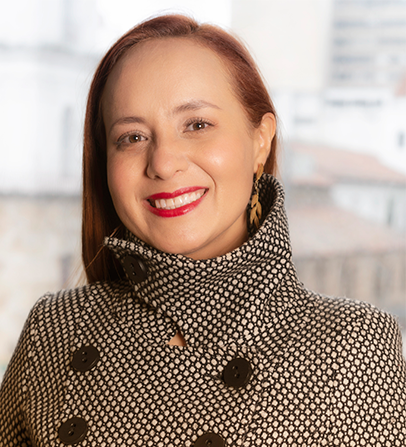The first thirty years of the Political Constitution of Colombia: A happy birthday?
By: Carlos Arturo García Bonilla
Photos: Ximena Serrano, Milagro Castro, Alberto Sierra y Juan Ramírez
Economics and Politics

By: Carlos Arturo García Bonilla
Photos: Ximena Serrano, Milagro Castro, Alberto Sierra y Juan Ramírez
On July 4th, 1991, the National Constitution governing our country was enacted. To commemorate its thirtieth anniversary, Universidad del Rosario held a meeting led by Diana Valencia Tello, Professor of the Faculty of Law, with scholars, experts, and magistrates to reflect on these 30 years of history. The result of this meeting was collected in the book Reflexiones y desafíos de la Constitución Política de 1991 tras treinta años de su expedición (Thoughts and Challenges of the 1991 Political Constitution Thirty Years after Its Promulgation), published by Editorial Universidad del Rosario. Based on this text, and thanks to the lucid support of Professor Valencia Tello, academic editor of the issue, we prepared a small guide to navigate through the twists of our constitution.
Historical backgrounds
We must remember that after the liberal revolutions that took place in the Western world at the onset of the 19th century, law rose in the modern State as a means to organize all aspects of the political, social, and economic life of communities. The idea was to formulate regulations that were as objective, general, and abstract as possible to apply them equally among the population. This idealist attempt, though praiseworthy in principle, had a fundamental problem: as it was based on abstract equality, it did not consider the diversity of different social realities, thereby deepening all kinds of inequalities throughout the 19th century.
For instance, if we consider the Civil Code, we can see it establishes a principle of formal equality among people. This sounds great on paper, but in reality, there are vast differences in the population that we must take into account. To exemplify, there is notable inequality between the owners of the capital and those who own nothing. If we do not consider this, we run the risk of experiencing what happened in the 19th century: under the principle of equality before the law, big companies would hire many people in subhuman conditions and keep them “tied” in the new factories being consolidated in industrialized countries.
The inequalities deepened by this principle of equality caused a series of strikes and demonstrations at the end of the century, which led to rethinking the law. It then materialized in a new kind of law striving for material equality. This is the main characteristic that set off the Social State of Law, which began gaining popularity by the end of the 19th century and the beginning of the 20th century.
The Social State of Law aims to highlight the differences among people. To continue our line of thought, workers without capital would need special protection from their employers so that they do not abuse their dominant position. This was also the beginning of a law intervening more in the State, which sought to develop different industries, economic areas, or public services. The classical liberal State was thought of as a minimal State that would let people do and let things go their way, dividing public and private matters to leave the latter in the hands of the market. However, inequalities and the abuse of the dominating position exerted by the elites in power caused a shift towards the Social State of Law.
What happened in Colombia?

The drafting of the new Colombian Magna Carta proposes a secular, inclusive, decentralized society that grants human rights and protects the environment; a peaceful society based on respect, able to address the strong social and economic inequalities that have historically existed in the country.

Main challenges of the Constitution
Although there are many challenges to our Constitution, three are worth mentioning: reconciling internal tensions created by State juridical pluralism, amplifying rights by using the constitutionality block, and addressing challenges implicit in the fourth industrial revolution.
Harmonizing state juridical pluralism
By attempting to establish a more horizontal juridical status, the 1991 Constitution granted a series of competences to certain bodies, which have created some conflicts around who has the last word. There is no single institution with complete autonomy, and this is where this interinstitutional dialogue becomes necessary, although this interaction does not always happen as a dialogue, but as judgments colliding with one another.

Is it a happy birthday? “The short answer is yes; it has been a happy birthday. The 1991 Constitution was undoubtedly a great step forward in our history, and it has helped to build a more decentralized and collaborative country. It has been the basis to build a more peaceful and, hopefully, equitable society. The long answer is that there is still a long way to go; that there are tensions created by the Constitution itself, and also potentialities still to be developed. It is even valid to wonder if it is now falling short in light of these new social realities,” concludes Professor Diana Valencia Tello from Universidad del Rosario.
In the first chapter of the book, Professor Nelcy López Cuéllar comments that the conceptualization of interinstitutional dialogue starts in Canada with several constitutional and political scientists, who spoke about a conflict between the Parliament and the Supreme Court on the control mechanism for law constitutionality. The philosophical problem of law in this sense is that dialogue should occur among equals.
However, in State structures, there are power hierarchies and relationships that are not necessarily symmetric, which ultimately affect dialogue by previously defining who, in practice, has the last word.
It is part of the democratic debate to keep fostering dialogue to find the most harmonic or better agreed-upon solutions that create the fewest conflicts. The core of the problem is evident when analyzing the structure of the State. The first US Constitution was based on the theory of checks and balances. This theory aims for one power to control the other.
In this sense, the structure is designed as a power battle that does not foster dialogue. This type of structure was devised in the 18th century, but nowadays, in complex societies, in information and knowledge societies where citizens usually have more access to data and communication, a decision based only on authority or hierarchy is no longer considered fair. It is necessary to find new mechanisms that enable the involvement of different points of view and help create consensus.
The argument that took place in the initial panel was focused in the High Courts. In several cases, the Constitutional Court has been placed as the institution with the last word, notwithstanding the opinions of the Supreme Court of Justice or the Council of State. However, it is necessary to closely analyze each case because the situation is usually more complex than simple hierarchy.
Part of the problem is that when institutions with well-defined competencies are established, each of them is autonomous to establish certain type of decisions. “In our legal system, there are several topics in which competence is shared among institutions, and they end up competing,” explains Professor Diana Valencia.
We can find a way out of this conflict in the 1991 Constitution itself. Article 113 establishes that the different State bodies have separate functions but collaborate with each other to reach the State goals. From this, we can infer a principle of “harmonic collaboration.” In the light of this principle, dialogue strategies among courts have been promoted, such as the creation of joint rooms for members of the different (high) courts to examine matters with converging competences to avoid divergent judgements that create these “train wrecks.”

Having no capital, workers need special protection so that their employers do not abuse their dominating position.
Notably, 105 years have passed between the 1886 and the 1991 constitutions. Over a century was needed to reach the decision that the then current Magna Carta was no longer meeting the needs of the population. We know our society changes now at a more rapid pace, and a signal of this is that only 30 years after its enaction, there are issues that raise the question of whether our Constitution is now failing to meet the needs of our current society.
Even when the new Constitution is more dynamic and flexible thanks to mechanisms such as the Constitutionality Block, there are realities that nobody could foresee. The digital revolution has created new means of forming relationships that is out of the scope of traditional juridical systems.
The Agere Research Incubator of Claustro del Rosario decided to address the issue of the social cost of this fourth industrial revolution by analyzing the situation in the context of delivery applications (apps). They have gained wide popularity in the latest years and have a relevant incidence in the country’s economy. However, the reality behind the conditions of their workers is far from ideal.
Rappi, an app created in Bogota in 2015, has grown to become one of the most used apps in the country. It delivers profits of around 550 million Colombian pesos. The biggest challenge lies in defending working rights for “rappitenderos” (“Rappi delivery people”), who are in charge of the message and delivery services, the company’s business purpose. Their legal situation is far from clear. The company categorically states that they are not their employees since there is no contract with them and that, in fact, the contract occurs between the Rappi delivery person and the client using the app.
In reality, Rappi delivery people are in a state of deep vulnerability. In spite of the great profits that the company makes, dispatchers receive a smidge amount, which forces them to work over ten hours a day to gather a vital minimum. According to Agere, approximately 70% of the service fee is collected by Rappi, while the delivery person collects the remaining 30%, that is, between $2,000 and $3,000 per service. Deliverypeople have no insurance, holidays, or minimum working conditions. Who is accountable for them?

The democratic debate should keep fostering dialogue to find more harmonic or better agreedupon decisions that do not create these many conflicts.
Article 53 of the Constitution states that “in case of discrepancy between the practice and what arises from documents and agreements, the first should prevail—that is, what happens in practice.” This is known as the primacy of reality principle. The legal twists and turns of the relationship between Rappi and its delivery people can be complex and ambiguous; however, it is clear that their reality is deplorable and that they are working in conditions that do not grant their working rights.
Let’s return to the beginning of the text to review the first article of the Constitution: Colombia is a Social State of Law. Let’s remember the spirit of this concept: to protect people from the abuse arising from inequalities.
It is clear that there is inequality and that it creates a deplorable situation in a vulnerable population. It is clear that to keep building the society we aimed for when we wrote our Constitution, we need to have tools to address all situations that create inequalities. If the situation remains, and we do not have the instruments to address them, we must ask ourselves whether we need new resources to face the current challenges.
Is it a happy birthday?
“The short answer is yes, it has been a happy birthday. The 1991 Constitution was undoubtedly a great step forward in our history, and it has helped to build a more decentralized and collaborative country. It has provided the foundations to build a more peaceful and, hopefully, equitable society. The long answer is that there is still a long way to go, that there are tensions created by the Constitution itself, and potentialities still to be developed. It is even valid to wonder if it is now falling short in light of these new social realities,” concludes Professor Diana Valencia Tello from Universidad del Rosario.
It is true that a country cannot be built upon decrees, and a law or constitution will not magically change society. However, it is worth remembering that communities are built around ideas and agreements, and our Constitution materializes the ideal that we have agreed upon as a community. Hence, it is vital to create these spaces of dialogue for us to reflect upon our Magna Carta. This is actually a way for us to think about ourselves as a community and to understand who we have been, who we are, and, above all, who we want to be in the future.